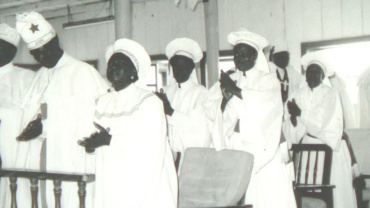Long after the sun dipped into the Atlantic and the coastal winds grew still, Ayetoro would come alive again. Along the shoreline, hundreds of tiny flames flickered against the darkness — lanterns carefully placed to guide worshippers gathering for the night vigil. To see the town aglow in the 1950s was to witness a living tapestry of faith: white-robed Apostles singing by lantern light, their voices carrying over the water until the sea itself seemed to echo their devotion.
The night vigil was one of the most sacred practices of the Holy Apostles’ Church. Unlike the Sunday morning service, which was marked by sunlight and communal joy, the vigil was intimate, solemn, and deeply spiritual. Families would arrive with lanterns in hand, placing them along the walkways, at the entrances of homes, and on the sandy shore where the congregation gathered. The flames transformed the settlement into a glowing village, every light a symbol of prayer offered to God.
Archival testimonies describe the atmosphere as unforgettable. Children clung to their mothers’ robes, mesmerised by the sea of lights; elders stood in stillness, staffs in hand, as hymns rose into the night sky. The sound of drums was softer than usual, keeping rhythm for chants and psalms that continued until dawn. For many, the vigil was not only worship but also renewal — a time to lay down fears, confess burdens, and strengthen the bonds that held the community together.
The lanterns themselves became part of the ritual. They represented guidance, protection, and divine presence. Oral histories recall how, when placed along the shoreline, the lights looked like stars that had descended to earth, encircling the people in a sacred embrace. Fishermen said the vigil gave them courage for the days ahead, as the glow of lanterns seemed to bless both sea and land. Women spoke of the comfort it brought, knowing that even in darkness, Ayetoro was united in prayer.
Visitors who stumbled upon the vigil in those years often wrote about it with awe. They described the shimmering line of lanterns stretching across the water, the chorus of voices rising into the night, and the impression of a town where heaven touched earth. Some likened it to biblical images of early Christians gathering in secret by firelight; others saw it as uniquely African — a blending of faith, song, and environment that could exist only in a coastal community.
For the Apostles, however, it was simply obedience to their covenant. They believed that worship did not end with the setting sun; rather, the night was another gift to be consecrated. As one elder later reflected: “The lanterns reminded us that light shines brightest in darkness. In those vigils, we were never afraid, for God was with us.”

Though many of those vigils are now memories, preserved in stories and photographs, their spirit continues to inspire. The image of lanterns glowing along Ayetoro’s shore remains one of the most enduring symbols of the Happy City — a reminder that even in the darkest hours, faith can light the way.




